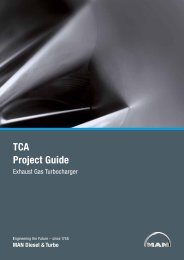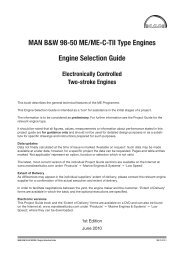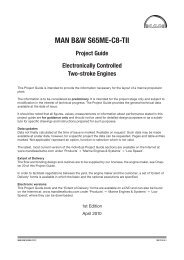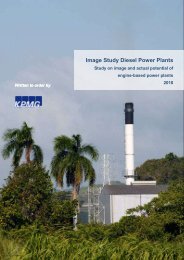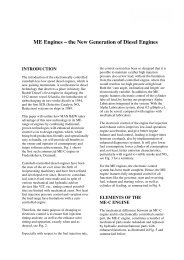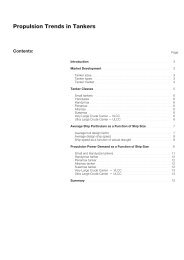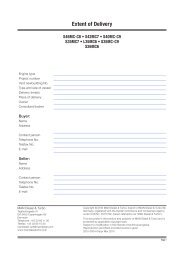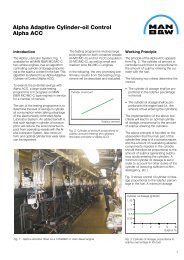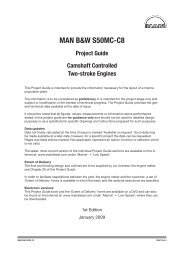This section is available on request - MAN Diesel & Turbo
This section is available on request - MAN Diesel & Turbo
This section is available on request - MAN Diesel & Turbo
Create successful ePaper yourself
Turn your PDF publications into a flip-book with our unique Google optimized e-Paper software.
<strong>MAN</strong> B&W 16.01<br />
• C<strong>on</strong>tinuous running c<strong>on</strong>trol of auxiliary functi<strong>on</strong>s<br />
handled by the ACUs<br />
• Alternative running modes and programs.<br />
Gas C<strong>on</strong>trol System<br />
The gas c<strong>on</strong>trol system for the -GI prime mover<br />
<str<strong>on</strong>g>is</str<strong>on</strong>g> an ‘interacti<strong>on</strong>’ between the traditi<strong>on</strong>al boil�off<br />
gas (BOG) handling, the well�known high�pressure<br />
compressor and the engine technology.<br />
Tanks Oxid<str<strong>on</strong>g>is</str<strong>on</strong>g>er Compressor Engine ME-GI<br />
Fig. 16.01.03: System c<strong>on</strong>figurati<strong>on</strong><br />
178 52 63�8.0<br />
When the gas evaporates, the boil�off gas increases<br />
the pressure in t he gas tanks and therefore<br />
has to be removed. <str<strong>on</strong>g>Th<str<strong>on</strong>g>is</str<strong>on</strong>g></str<strong>on</strong>g> gas c<strong>on</strong>tains methane<br />
and nitrogen.<br />
In order to boost the pressure for further working,<br />
a turbo compressor <str<strong>on</strong>g>is</str<strong>on</strong>g> used to activate a pressure<br />
at approximately 2 bar.<br />
The above�menti<strong>on</strong>ed flow of the boil�off gas <str<strong>on</strong>g>is</str<strong>on</strong>g><br />
the traditi<strong>on</strong>al flow which has been used in gas<br />
carriers for years.<br />
In order to burn the boil�off gas in a high�pressure<br />
gas engine, a reciprocating compressor has to be<br />
installed.<br />
These compressors are well�known and used with<br />
various kinds of gases, delivered in units including<br />
all internal c<strong>on</strong>trol of the system, which operates<br />
together with engines. Futher the c<strong>on</strong>trol system<br />
has sufficient ability to adjust optimal flow to engines<br />
if the c<strong>on</strong>diti<strong>on</strong> of the boil�off gas, to the<br />
compressi<strong>on</strong> or requirements for the engine be<br />
changed. These gas compressors use c<strong>on</strong>trol of<br />
by�pass at engine part load, all depending of the<br />
applicati<strong>on</strong> necessary; please see the gas supply<br />
systems, Secti<strong>on</strong> 7.07.<br />
Page 3 of 11<br />
The compressors are capable of operating at engine<br />
shutdown and of manoeuvring the system<br />
without any delay or other difficulties, may appear<br />
for the operator. The operator will, in practice,<br />
operate the -GI engine as an ordinary HFO ME<br />
engine.<br />
Engine c<strong>on</strong>trol and safety system<br />
The -GI c<strong>on</strong>trol and safety system <str<strong>on</strong>g>is</str<strong>on</strong>g> built as an<br />
add�<strong>on</strong> system to the ME c<strong>on</strong>trol and safety system.<br />
It hardly requires any changes to the ME<br />
system, and it <str<strong>on</strong>g>is</str<strong>on</strong>g> c<strong>on</strong>sequently very simple to<br />
implement.<br />
The principle of the gas mode c<strong>on</strong>trol system <str<strong>on</strong>g>is</str<strong>on</strong>g><br />
that it <str<strong>on</strong>g>is</str<strong>on</strong>g> c<strong>on</strong>trolled by the error between the wanted<br />
d<str<strong>on</strong>g>is</str<strong>on</strong>g>charge pressure and the actual measured<br />
d<str<strong>on</strong>g>is</str<strong>on</strong>g>charge pressure from the compressor system.<br />
Depending <strong>on</strong> the size of th<str<strong>on</strong>g>is</str<strong>on</strong>g> error the amount of<br />
fuel�gas (or of pilot oil) <str<strong>on</strong>g>is</str<strong>on</strong>g> either increased or decreased.<br />
If there <str<strong>on</strong>g>is</str<strong>on</strong>g> any variati<strong>on</strong> over time in the calorific<br />
value of the fuel�gas it can be measured <strong>on</strong> the<br />
rpm of the crankshaft. Depending <strong>on</strong> the value<br />
measured, the amount of fuel�gas <str<strong>on</strong>g>is</str<strong>on</strong>g> either increased<br />
or decreased.<br />
The change in the calorific value over time <str<strong>on</strong>g>is</str<strong>on</strong>g> slow<br />
in relati<strong>on</strong> to the rpm of the engine. Therefore the<br />
required change of gas amount between injecti<strong>on</strong>s<br />
<str<strong>on</strong>g>is</str<strong>on</strong>g> relatively small.<br />
To make the engine easy to integrate with different<br />
suppliers of external gas delivering systems,<br />
the fuel gas c<strong>on</strong>trol system <str<strong>on</strong>g>is</str<strong>on</strong>g> made almost ‘stand<br />
al<strong>on</strong>e’. The exchanged signals are limited to Stop,<br />
Go, ESD, and pressure set�point signals.<br />
<strong>MAN</strong> B&W ME/ME-C/ME-B/-GI engines 198 49 28-03<br />
<strong>MAN</strong> <strong>Diesel</strong>



